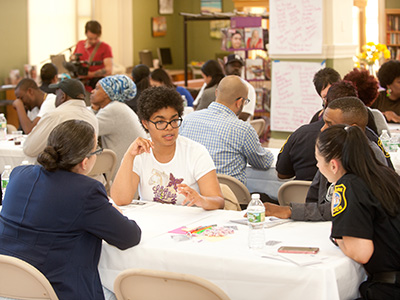Pillar 2: Community-Led Strategies
The idea of bridge building is that we can break down barriers that might seem insurmountable or make connections where they aren’t readily apparent. Success might lead to the development of trust or understanding through shared values.
Bridge building is crucial when it comes to a public safety ecosystem. The dominant narrative around safety is that police officers create it. But in Black and Brown communities that bear the brunt of violence — including police violence — that doesn’t feel true. The long history of police oppression has created generational mistrust and hostility, and a binary that one side is good and the other is bad.
Police must play a role in public safety, but they cannot deliver it on their own because they don’t understand the needs of the community. Only through a collaborative relationship with the community can police help keep neighborhoods safe. They need to reckon with the trauma that police brutality and oppression inflict on the community and work to overcome it.
Trauma to Trust (T2T) is the type of program that offers an opportunity for police officers and community members to acknowledge each person’s experiences and explore what happened to ultimately overcome historical trauma.
 T2T spans 16 hours over two full days. A primary goal is to ensure that community members and cops can start a healing journey, which is spurred from acknowledging the personal dimensions of trauma in one’s own life. Community members realize that violent episodes and oppression are not and should not be normalized. Police officers explore the nature of their jobs, the risks they undertake every day, and the expectations they face.
T2T spans 16 hours over two full days. A primary goal is to ensure that community members and cops can start a healing journey, which is spurred from acknowledging the personal dimensions of trauma in one’s own life. Community members realize that violent episodes and oppression are not and should not be normalized. Police officers explore the nature of their jobs, the risks they undertake every day, and the expectations they face.
The goal of T2T is to connect individual experiences to historical processes and re-center trauma and violence, resilience and agency. Through this bridge building exercise, human beings understand that harm is universal but looks and feels different to everyone. This deeper understanding allows for empathy and leads to increased safety.


